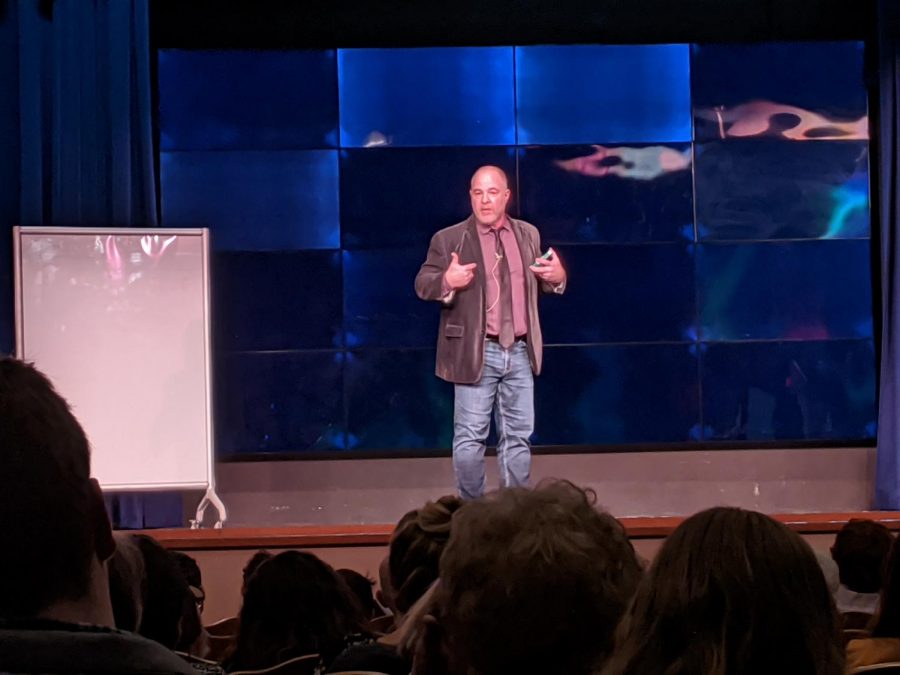Jackson Katz flips the narrative on gender violence
The ‘Toxic Masculinity’ presentation helps students understand the awareness of gender violence
More stories from Klaus Ebenhoch
Photo by Bridget Kelley
Jackson Katz about toxic masculinity at The Forum series Tuesday night.
Masculinity: its influence on the media, the harm social constructs give to boys and men and the ways all individuals can work towards a solution for gender violence. All topics addressed by Jackson Katz in the “Toxic Masculinity” forum.
“Toxic Masculinity” was a presentation hosted by The Forum series at UW-Eau Claire. Katz delivered his presentation on Mar. 10 in Schofield auditorium. With a purpose to change the way people describe and educate on the topic of gender violence.
Katz delivers presentations around the world on this topic. He works with governmental and non-governmental organizations on interventions and strategies to address the topic of gender violence.
One of the main points Katz made was on how boys and men are raised in a system that not necessarily promotes violence, but normalizes it. Katz made a film titled “Tough Guise,” which details the way masculinity is presented in media and film production. He describes the way men use guns, muscles and violence to model the ways problems are solved.
“John Wayne is a cowboy in old Western movies,” Katz said. “He solves problems with guns, fists and a cold stare.”
These models for problem solving create a toxic culture in men. The consequences of these models are seen amongst many in society, where culture of abuse is enforced onto children of men that act violently.
According to Katz, a boy who has been abused is ten times more likely to abuse others. Katz said these statistics affect modern society regularly.
“57 percent of school shootings have connections to domestic violence cases,” Katz said. “99 percent of school shootings are done by men.”
The overarching value of the “Toxic Masculinity” presentation was to support the claim that gender violence is not just a women’s issue, it is everyone’s issue. According to Katz, the use of passive voice shifts the problem of gender violence on women.
Grace Kotrly, a second-year elementary education student, said she appreciated how Katz summarized this concept into a simple statement.
“We need to start using the term ‘men’s violence against women’ instead of ‘violence against women,’ ” Kotrly said. “It’s such an important political statement that reshapes how we think of gender violence.”
Katz concluded by teaching the bystander method to combat the culture of gender violence. The bystander method is a way that avoids discipline to discourage sexist and violent behavior, but creates a culture where behavior is condemned and discouraged.
According to WBUR, an active bystander is someone who intervenes to interrupt behaviors in social situations that could lead to sexual violence.
This not only means intervening when an violent or abusive activity is occurring, but calling out men for sexist comments, insensitive jokes, micro-incidents and other harmful behavior. The purpose of the bystander method is to stop toxic masculinity at the root of the problem and to discourage behavior that could lead to incidents.
Brittany Kirchoff, third-year English and professional communications student, said she recognizes the danger of letting this behavior happen without calling it out.
“Another problem is the culture that society lets men get away with microaggressions that feed into our environments because, ‘it’s just a joke,’ ” Kirchoff said. “These incidents of microaggressions stand at the base holding a ladder for potential violence.”
For those who were unable to attend Katz’s “Toxic Masculinity” presentation, there’s still plenty of ways you can learn about gender violence.
Katz has published books, such as “Man Enough? Donald Trump, Hillary Clinton and the Politics of Presidential Masculinity.” Katz’s first book is titled “The Macho Paradox: Why Some Men Hurt Women and How All Men Can Help.”
Katz also has a website for gender violence prevention techniques. It contains useful information about the philosophy and methods of the Mentors in Violence Prevention model.
Ebenhoch can be reached at ebenhoka4004@uwec.edu.

Bridget Kelley is a fourth-year journalism student. Bridget enjoys hanging out with babies, coffee and oxford commas. If anyone has any gluten-free food suggestions, Bridget's inbox is open.

